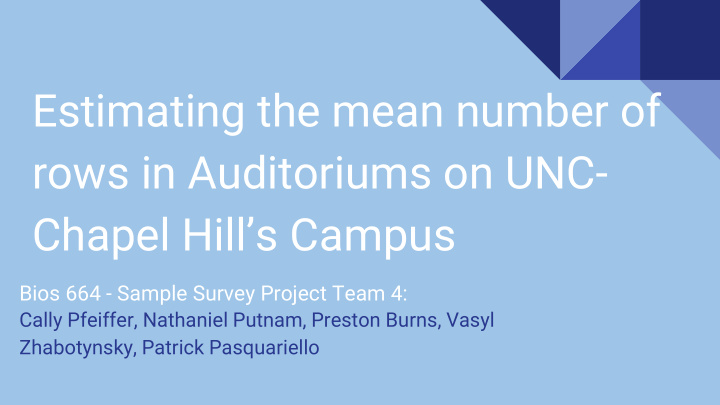



Estimating the mean number of rows in Auditoriums on UNC- Chapel Hill’s Campus Bios 664 - Sample Survey Project Team 4: Cally Pfeiffer, Nathaniel Putnam, Preston Burns, Vasyl Zhabotynsky, Patrick Pasquariello
Population We consider our target population to be all UNC - Chapel Hill Auditoriums ○ At least 50 seats that are nailed or fixed to the floor ○ Auditorium in their name will also be included The members of the target population: individual auditoriums ○ Observational units: individual auditoriums. ○ Observations will be taken to count the number of rows in each auditorium.
Sampling Design Two Initially Proposed Designs: SRS with Stratification by seating capacity Cluster Sample based on Geographic proximity Calculated and compared variances for different sample sizes under both of these designs to determine which one to use The stratified SRS offered greater precision and was consequently chosen as our sampling design
Sampling Process Make 3 10 Sampling Frame: 7 Auditoriums Auditoriums strata and 39 Auditoriums in sample in Sample choose sample 3 Auditoriums pulled out - sampled for free by online floor plans
Initial Considerations ŷ 39 = (12* ŷ 36 +y 3 )/13, E( ŷ 39 )= (12/13)E( ŷ 36 )+(1/13)y 3 , because y 3 is constant. Where y 3 is the mean of the free cost auditoriums and ŷ 36 is the estimate of the mean of the remaining 36 auditoriums. final estimate of mean: ŷ 39 =(1/13)*y 3 +(12/13)* ŷ 36 Final estimate of variance: Var( ŷ 39 )= (144/169)Var( ŷ 36 ) Preliminary variance estimates: square root of seating capacity. The target standard error of our estimate is ±1 row.
Data Collection Methods The row counts for auditoriums without online floor plans were obtained by physically visiting their buildings and manually counting their rows Measurement Problems Encountered Definition of a row
Final Considerations The sample is not EPSEM, but sample weights were not difficult to calculate. Within each stratum an SRS was conducted, so the sample weight of each observation within a stratum is equal: 6 for stratum 1 observations, 6 for stratum 2 observations, and 3 for stratum 3 observations. Our Sample Frame may be incomplete. Unknown auditoriums are probably small, so our estimate may be biased high. Sensitivity analysis suggests that we’re fine.
Results (1) In addition to stratified sample estimate we also consider linear regression fit (as well as checking if our assumption during stratification was reasonable) The figure to the right illustrates that linear fit is quite good either with or without intercept, except for the thrust type auditorium format marked as red circle (Paul Green Theater)
Results (2) model Mean S.E. 95%CI In the table to the right you may observe the results from 3 lm(y~a+b x) 10.96 0.67 (9.38,12.53) models: Stratified 11.03 0.73 (9.23,12.82) sampling * linear regression fit (on a Sensitivity 10.89 0.76 (9.04,12.75) square root of total capacity) analysis * originally planned method All three methods give quite consistent * sensitivity analysis assuming 2 results, which suggest that we have a auditoriums escaping a robust estimate of about 11 rows, give or take 2 rows. sampling frame
Acknowledgements Libby Taylor, School of Pharmacy Mary Pettiette and Alicia Ramsaran, School of Dentistry Philip Spangler, School of Law Veronica Stallings, School of Public Health Jodi Abatemarco, School of Education Catherine Nichols, School of Business Lara Bailey, School of Information and Library Science Jamarian Monroe, School of Government Lauren Tillet-Wakeley, College of Arts and Sciences
Questions? Thank you!
data strat_popsize; Code used for Analysis: set strat_popsize; _total_=COUNT; proc import out=work.allaud drop COUNT PERCENT; datafile = RUN; "C:\courses\2016S\BIOS664\auditorium\auditorium. proc import out=work.aud3 csv" datafile = DBMS = csv replace; "C:\courses\2016S\BIOS664\auditorium\sampled.csv getnames = yes; " datarow=2; DBMS = csv replace; run; getnames = yes; proc sort data=allaud; datarow=2; by strata; Run; run; proc surveymeans data=work.aud3 plots=none N=strat_popsize total=strat_popsize plots=none; *Create data set 'strat_popsize' with stratum population counts*/ strata stratum; proc freq data=allaud noprint; var numrow; tables stratum/nocum nopercent weight weight; out=strat_popsize; run; run;
proc import out=work.strat_popsize datafile = Continued "C:\courses\2016S\BIOS664\auditorium\strat_pops ize_sens.csv" proc descript data=work.aud3 notsorted DBMS = csv replace; design=wor; getnames = yes; datarow=2; nest stratum; /*indicates that we run; stratify*/ proc surveymeans data=work.audu plots=none totcnt fpc; N=strat_popsize total=strat_popsize weight weight; plots=none;; var numrow; strata stratum; print nsum="Sample Size" total wsum="Est Pop var numrow; /* weight*/ Size" mean semean lowmean upmean; weight weight; /*sampling weight*/ run; run; proc descript data=work.audu notsorted proc import out=work.audu design=wor; datafile = nest stratum; /*indicates that we "C:\courses\2016S\BIOS664\auditorium\under_sampl stratify*/ ed.csv" totcnt fpc; DBMS = csv replace; weight weight; getnames = yes; var numrow; datarow=2; print nsum="Sample Size" total wsum="Est Pop Run; Size" mean semean lowmean upmean; run;
Recommend
More recommend